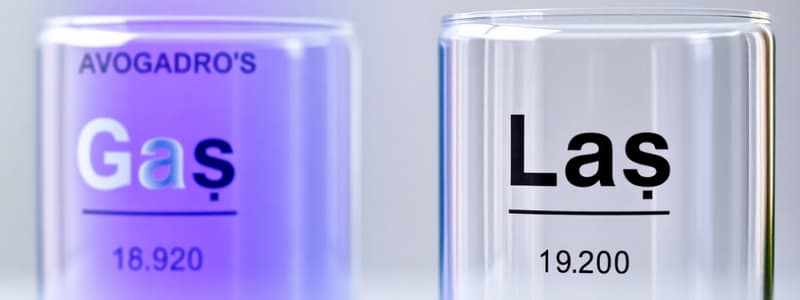Podcast
Questions and Answers
How do you determine the total number of valence electrons in a negative ion?
How do you determine the total number of valence electrons in a negative ion?
- Subtract the number of positive charges from the total valence electrons.
- Count the number of electrons in the outer shells of each atom.
- Add the valence electrons of each atom and the number of negative charges. (correct)
- Add the valence electrons of each atom only.
What is the first step in writing the Lewis structure for a molecule or ion?
What is the first step in writing the Lewis structure for a molecule or ion?
- Distribute lone pairs to complete the octet.
- Identify the central atom in the molecule.
- Determine the total number of valence electrons. (correct)
- Draw a skeleton structure connecting atoms.
In the case of a positive ion, how is the number of valence electrons calculated?
In the case of a positive ion, how is the number of valence electrons calculated?
- Only use the total valence electrons of the central atom.
- Add valence electrons and subtract the number of negative charges.
- Add the valence electrons and subtract the number of positive charges. (correct)
- Subtract the valence electrons of the terminal atoms from the total.
When writing the Lewis structure for OF2, how are the valence electrons counted?
When writing the Lewis structure for OF2, how are the valence electrons counted?
What is the purpose of drawing a skeleton structure in the Lewis structure process?
What is the purpose of drawing a skeleton structure in the Lewis structure process?
Why are lone pairs distributed on terminal atoms during Lewis structure drawing?
Why are lone pairs distributed on terminal atoms during Lewis structure drawing?
How do you denote the charge of an ion in a Lewis structure?
How do you denote the charge of an ion in a Lewis structure?
What does Avogadro's law state about gases?
What does Avogadro's law state about gases?
What is the volume occupied by one mole of any gas at standard temperature and pressure (STP)?
What is the volume occupied by one mole of any gas at standard temperature and pressure (STP)?
What unique characteristic does xenon exhibit in its compounds compared to other noble gases?
What unique characteristic does xenon exhibit in its compounds compared to other noble gases?
According to Dalton’s law of partial pressures, how is the total pressure of a gas mixture calculated?
According to Dalton’s law of partial pressures, how is the total pressure of a gas mixture calculated?
Which of the following statements is true according to John Dalton's atomic model?
Which of the following statements is true according to John Dalton's atomic model?
What concept regarding atoms did Democritus propose?
What concept regarding atoms did Democritus propose?
Which scientist is credited with discovering the electron?
Which scientist is credited with discovering the electron?
What did John Dalton believe about atoms during chemical reactions?
What did John Dalton believe about atoms during chemical reactions?
In the context of modern atomic theory, what is NOT considered true about atoms?
In the context of modern atomic theory, what is NOT considered true about atoms?
What does Schrödinger's atomic model indicate about electron motion?
What does Schrödinger's atomic model indicate about electron motion?
According to the Pauli Exclusion Principle, what can be said about electrons in the same atom?
According to the Pauli Exclusion Principle, what can be said about electrons in the same atom?
Which of the following quantum numbers describes the shape of an orbital?
Which of the following quantum numbers describes the shape of an orbital?
What is the significance of the spin quantum number in electron configuration?
What is the significance of the spin quantum number in electron configuration?
If two electrons are in the same energy level and sublevel, what can be inferred about their quantum numbers?
If two electrons are in the same energy level and sublevel, what can be inferred about their quantum numbers?
Which of the following statements is true regarding atomic structure?
Which of the following statements is true regarding atomic structure?
Which quantum number is not derived from the wave function?
Which quantum number is not derived from the wave function?
What does the notation of quantum numbers represent in relation to electrons?
What does the notation of quantum numbers represent in relation to electrons?
What type of hybridization occurs in phosphorus pentafluoride (PF5)?
What type of hybridization occurs in phosphorus pentafluoride (PF5)?
Which hybrid orbitals are formed to account for the geometry of SF6?
Which hybrid orbitals are formed to account for the geometry of SF6?
How many unpaired electrons does phosphorus have in its ground state configuration before hybridization?
How many unpaired electrons does phosphorus have in its ground state configuration before hybridization?
What is the oxidation state of Nickel in the complex ion [Ni(CN)4]2-?
What is the oxidation state of Nickel in the complex ion [Ni(CN)4]2-?
What explains the lower energy of hexaaquoiron(II) compared to hexacyanoiron(II)?
What explains the lower energy of hexaaquoiron(II) compared to hexacyanoiron(II)?
Which geometry is associated with the hybridization of dsp2?
Which geometry is associated with the hybridization of dsp2?
What model has replaced the 'inner-outer' hybrid model in explaining transition metal complexes?
What model has replaced the 'inner-outer' hybrid model in explaining transition metal complexes?
In what type of geometry do six sp3d2 hybrid orbitals typically arrange themselves?
In what type of geometry do six sp3d2 hybrid orbitals typically arrange themselves?
What determines the molecular geometry according to VSEPR theory?
What determines the molecular geometry according to VSEPR theory?
In the AXE method of electron counting, what does 'E' represent?
In the AXE method of electron counting, what does 'E' represent?
What is the significance of the steric number in VSEPR theory?
What is the significance of the steric number in VSEPR theory?
Which of the following statements about VSEPR theory is true?
Which of the following statements about VSEPR theory is true?
Exceptions to VSEPR predictions often involve which type of compounds?
Exceptions to VSEPR predictions often involve which type of compounds?
Which theory can predict the structure of metal hydrides when VSEPR fails?
Which theory can predict the structure of metal hydrides when VSEPR fails?
What does the 'AX2E1' notation indicate about a molecule's geometry?
What does the 'AX2E1' notation indicate about a molecule's geometry?
Which conclusion can be drawn regarding the prediction of geometry in coordination complexes?
Which conclusion can be drawn regarding the prediction of geometry in coordination complexes?
Flashcards are hidden until you start studying
Study Notes
Avogadro's Law
- States that equal volumes of gases at the same temperature and pressure contain equal numbers of moles or molecules.
- The volume of a gas is directly proportional to the number of moles of gas present (V & n) when temperature and pressure are constant.
- One mole of any gas at a given temperature and pressure has the same fixed volume, called the molar gas volume.
- At standard temperature and pressure (STP), one mole of any gas occupies a volume of 22.4 liters.
Dalton's Law of Partial Pressures
- States that the total pressure of a mixture of gases is equal to the sum of the partial pressures of all the gases present.
- Each component gas in a mixture exerts a pressure as if it were alone in the container.
- The individual pressure of each gas in the mixture is defined as its partial pressure.
- The law is expressed as P = P1 + P2 + P3 + ... (V and T are constant), where P is the total pressure and P1, P2, P3, etc. are the partial pressures of each gas.
Democritus' Atomic Theory
- Proposed by the Greek philosopher Democritus around 400 BC.
- Suggested that all matter consists of indivisible particles called atoms.
- Believed that atoms were solid, had no internal structure, and differed in size, weight, and shape.
John Dalton's Atomic Model
- The first modern atomic model, building upon Democritus' ideas.
- Key postulates:
- All matter consists of tiny particles called atoms.
- Atoms are indestructible and unchangeable.
- Elements are characterized by the weight of their atoms.
- When elements react, their atoms combine to form new compounds.
J.J. Thomson's Discovery of the Electron
- Using cathode ray tube technology, Thomson discovered the electron in the 1890s.
- His model suggested that atoms were positively charged spheres with negatively charged electrons embedded within.
Erwin Schrödinger's Atomic Model
- Utilizing Heisenberg's uncertainty principle, Schrödinger developed the modern atomic model in the 1920s.
- Known as the cloud model, it suggests that electrons do not travel in exact orbits, but rather in regions of probability where they are likely to be found.
Atomic Structure Summary
- An atom is the smallest part of an element.
- Each atom of an element has a unique structure.
- Atoms can be divided into smaller subatomic particles: protons, electrons, and neutrons.
Quantum Numbers
- Describe the location and properties of electrons within an atom or ion.
- Four types of quantum numbers:
- n (principal): determines the energy level of an electron.
- l (orbital): determines the shape of the orbital.
- ml (magnetic): designates a particular suborbital.
- s (spin): describes the intrinsic angular momentum of an electron (spin up or spin down).
Pauli Exclusion Principle
- States that no two electrons within an atom can have the same four quantum numbers.
- This principle explains why electrons occupy different energy levels, orbitals, and spin states.
Types of Atomic Orbitals
- The most probable area to find an electron takes on a specific shape.
- Four main types of atomic orbitals:
- s: spherical.
- p: dumbbell shaped.
- d: more complex shapes.
- f: even more complex shapes.
Writing Lewis Structures with the Octet Rule
- Lewis structures are diagrams representing the bonding and lone pairs of electrons surrounding an atom.
- The octet rule states that atoms tend to gain, lose, or share electrons to achieve a stable configuration of eight electrons in their outermost shell.
- Steps to write Lewis structures:
- Determine the total number of valence electrons.
- Draw a skeleton structure with single bonds between atoms.
- Distribute remaining electrons as lone pairs to complete octets.
VSEPR Theory
- Valence Shell Electron Pair Repulsion (VSEPR) Theory predicts the shape of molecules based on the repulsion between electron pairs around a central atom.
- The steric number refers to the total number of electron pairs surrounding an atom, including bonding and lone pairs.
- The AXE method uses the symbols A, X, and E to represent the central atom, sigma bonds, and lone pairs, respectively.
- VSEPR theory predicts molecular geometries based on the steric number and the distribution of X and E.
Exceptions to VSEPR Theory
- Some compounds, especially transition metal complexes, do not have geometries predicted by VSEPR.
- This is due to the interaction of core d-electrons with ligands.
- Other theories, like VALBOND Theory and Crystal Field Theory, are used to predict the geometry of these exceptions.
Hybridization involving d-orbitals
- Hybridization refers to the mixing of atomic orbitals to form new hybrid orbitals with different shapes and energies.
- d-orbitals can participate in hybridization, resulting in different geometries and bonding characteristics.
- Examples include sp3d-hybridization in PF5 and sp3d2-hybridization in SF6.
Octahedral Geometry
- Occurs in molecules with sp3d2-hybridization of the central atom.
- Six identical ligands are arranged around the central atom in a symmetric octahedral shape.
Square Planar Geometry
- Occurs in molecules with dsp2-hybridization of the central atom.
- Four identical ligands are arranged around the central atom in a square planar shape.
Studying That Suits You
Use AI to generate personalized quizzes and flashcards to suit your learning preferences.




